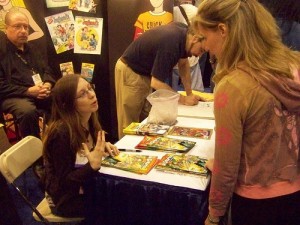Breaking into Comics
One of the questions I’m frequently asked is how to go about “breaking into” the comic industry. It’s a tricky question to answer, because there is no direct path. The comics industry is a tough business to break into. There’s a lot of competition. And even once you’re “in”, every new assignment or project still requires effort to get (though publishing credits do help!).
The most important thing you’ll need are strong, stand-out sample comic pages that demonstrate your skills in sequential art. You need to be capable of drawing characters consistently on-model and capable of expressing a gamut of emotions, as well as the ability to draw backgrounds in perspective, clarity in sequential storytelling, dynamic action, and clear but exciting panel layouts. The best way to get that is to keep working at it. The more you draw, the better you’ll get. Challenge yourself to draw outside of your comfort zone. Draw everything, not just people. The ability to draw human characters is, of course, essential, but comic artists should ALSO be able to draw whatever the script calls for: backgrounds from busy cityscapes to dense forests, cute puppies to ferocious beasts, racing cars to horse-drawn wagons.
Depending on the publisher, the way to get your work seen is to take it to a convention where an editor is doing portfolio reviews. They can give you the feedback you need to further improve your pages, or if your work is good enough, hire you on the spot.
The way I got my start with Tokyopop was through their 2nd Rising Stars of Manga competition. (Tokyopop is no longer doing the Rising Stars of Manga, but nowadays there are also other competitions running such as Kodansha’s Morning Magazine International Comic Contest, in which Jared’s and my entry, Last Dance, placed as a finalist).
For RSOM, I followed the guidelines, and sent off a short self-contained 20-page comic that landed me grand prize. The editors loved it so much that they asked me to put together a full three-volume version of the series. You know how that turned out. The series was Peach Fuzz. 🙂 From there, I had the credentials and work behind me to get a job as a penciler on Sabrina the Teenage Witch over at Archie Comics.
If you’re interested in writing and drawing stories, the steps are similar but somewhat different. You’ll need to put together a comic pitch based on your desired publisher’s guidelines. Every publisher is different about what they want. It helps to be aware of which publishers are looking for submissions, and what they want, so that you can tailor your submission to their needs. Check publisher websites for guidelines. But in general, it amounts to about 10-15 sample comic pages, a short (2-3 pages) synopsis of how the story would play from start to finish, character designs and bios, and a persuasive query letter.
(There’s also self-publishing and web comics. But that’s a topic for another day.)
I wish you the best of luck in your efforts! 🙂

Discussion ¬